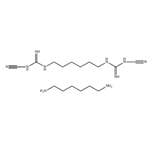Uses
Poly(hexamethylenebicyanoguanide-hexamethylenediamine) Hydrochloride is used in the stabilization of fabric linings in shoes. Biguanide solution used in cleaning contact lenses.
Application
Polyhexamethylene biguanide hydrochloride has a broad-spectrum antibacterial, Gram-positive bacteria, Gram-negative bacteria, fungi and yeast, etc. have a killing effect. It is commonly used in women's lotion, sanitary wipes sterilization and anti-mold agent, fruit and vegetable, aquatic products disinfectant, sewage treatment flocculation disinfectant, etc.
Application
In addition to its use as a biocide, PHMB is a preservative in cosmetics and is considered safe when used at concentrations of ≤ 0.1% (approximately 1 mg/mL; 3.5 mM), according to the Scientific Committee on Consumer Safety. Moreover, PHMB can be found in medicinal (e.g., perioperative cleansing products, wound care dressings), industrial (e.g., swimming pool disinfectants, leather preservatives, agricultural and food handling cleaners), and consumer products (e.g., wet wipes, contact lens cleaning solution). It is used as an ophthalmic agent in the 0.02–0.08% concentration range. In other applications, such as swimming pool disinfection and shampoos, PHMB may be present at concentrations ranging from 0.03% to 4%. Therefore, exposure levels are generally expected to remain below 0.02%.
Mechanism of action
Poly(hexamethylenebicyanoguanide-hexamethylenediamine) hydrochloride (PHMB), a synthetic polymer, is a cationic biocide used as a disinfectant because of its broad-spectrum antibacterial activity. PHMB interacts with the negatively charged head group of phospholipids, resulting in increased permeability, fluidity, and loss of integrity, ultimately causing mortality of microorganisms. PHMB can exhibit a biocidal effect by penetrating the cytoplasm and binding to DNA and RNA; hence, it significantly impacts cell biological systems such as cell growth and division, as well as nucleic acid replication and repair. Interestingly, in mammalian cells, PHMB is trapped within endosomes and excluded from the nucleus, suggesting that PHMB selectively binds and condenses bacterial chromosomes to exhibit antibacterial activity.
Side effects
While most literature reports minimal skin irritations and few side effects, it is notable that a hospital disinfectant containing 0.2% PHMB has been reported to trigger severe anaphylaxis. Furthermore, some patients with keratitis treated with 0.2% PHMB experienced ocular toxicity, including conjunctival inflammation and epithelial defects. Stability studies on ophthalmic formulations of PHMB revealed that PHMB was physicochemically stable throughout the study for up to 2 months.
Metabolism
It is unclear how Poly(hexamethylenebicyanoguanide-hexamethylenediamine) hydrochloride (PHMB) is metabolized in vivo; however, most rodent studies involving exposure to PHMB through dietary and drinking water intake in the range of 20–2000 ppm or 20–4000 mg/kg suggest that the primary excretion routes are feces and urine. In rats exposed to PHMB through their diet, the substances 3,3-dicyano-1,1-hexamethylene-diguanidine and 1-(6-aminohexyl)? 3-cyanoguanidine were detected in the urine.
Toxicity evaluation
Cytotoxicity to Poly(hexamethylenebicyanoguanide-hexamethylenediamine) hydrochloride (PHMB) has been shown in several human-derived cell lines, such as human dermal keratinocytes, dermal fibroblasts and osteoblasts, and lung adenocarcinoma cells. Toxicological studies have revealed that PHMB induces a severe inflammatory response and can trigger cytotoxicity through endoplasmic reticulum stress. The liver and kidneys are the target organs for PHMB, but they also affect the lungs. PHMB can alter the cell membrane structure and permeability, which can have significant consequences when interacting with neurons within the nervous system.



